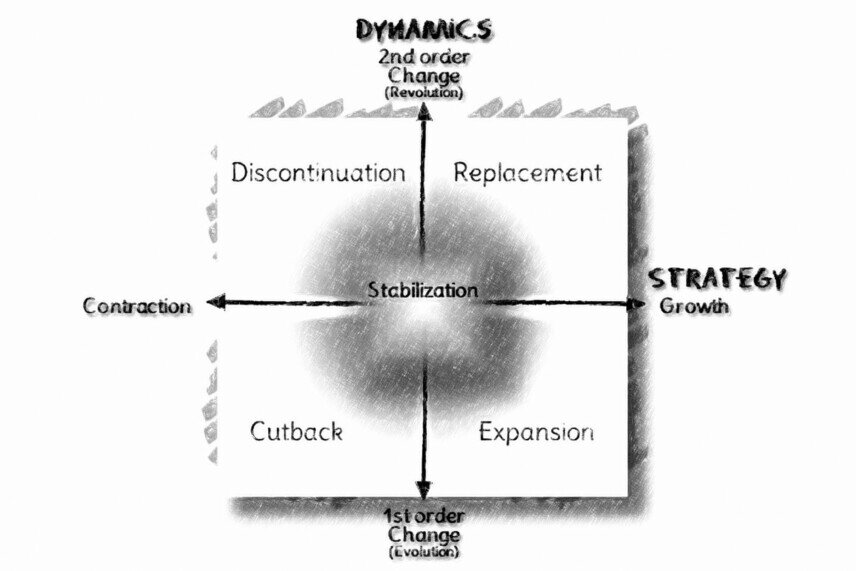Change portfolio
The change portfolio serves as a visualization of
changes. It enables the positioning of individual scenarios as well as to
control the completeness of the scenario planning. It is primarily used for
strategy development and change management.
The two dimensions describe change dynamics and change strategy. The
crossover of the two axles represents the ‘absolute zero point’ of change.

- Change dynamics
From the center (‚absolute zero point’), 1st order changes are expanding downwards, and 2nd order changes upwards. 1st order changes are continuous improvements, which produce small changes in small steps. These are modifications, which increase the efficacy and efficiency („doing the right thing right “) as well as to implement other improvements. Depending upon the strategy, these are cutback or expansion activities. These evolutionary developments create large, sustainable changes over a long time, e.g., transforming communication behavior by the Internet (society). Changes of the 2nd order are drastic changes, which happen on short notice. These changes replace the existing conditions by discontinuing something, replacing it with a copied idea or a radical, sometimes unrealistic innovation. Depending upon strategy, this can be discontinuation or replacement of existing conditions. Within a short time, this revolutionary disruption creates massive changes with high risk, e.g., the development of the MP3-Formats in the 80s/90s and the associated changes in music consumption (society).
- Change strategy
At the ‘absolute zero point’ stabilization strategies are located. To the left, extend contraction and to the right growth strategies. Stabilization strategies pursue the goal to maintain the current conditions and to work against any change. Stabilization is predominantly used in crises, e.g., if respected Thai king Bhumipol Adulyadej sends messages for the appeasement of the political situation to the people. Contraction strategies pursue the strategy „less is more“. Depending on change dynamics, it is cutback or even discontinuation of existing conditions. It involves, for example, product range, worldwide production locations, or personnel, e.g. the concentration of Mercedes' traditional vehicle business since the 90s. Growth strategies pursue expansion strategies. Depending upon change dynamics, it can be an expansion or even replacement. In any case, it might involve market shares, revenue, site extensions, globalization, or even purchase of other enterprises, e.g., the different IPODs of the company Apple, which created a market share from over 92% in the USA in 2010.
This change portfolio covers all possible directions of change. Differences result from the strength of the change.

